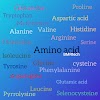Asparagine | History | Biosynthesis | Applications....
ASPARAGINE AMINO ACID
History -
In 1809, Pierre Jean Robiquet identified a substance from
liquorice root with properties which he qualified as very similar to
those of asparagines. and which Plisson identified in 1828 as asparagine
itself.
Introduction-
Asparagine is a non-essential amino acid in humans. Asparagine is
α-amino acid that is used in the biosynthesis of proteins. Asparagine is a
beta-amido derivative of aspartic acid and plays an important role in the
biosynthesis of glycoproteins and other proteins. It contains an α- amino group
an α-carboxylic acid groups and a side chain carboxamide, classifying it as a
polar aliphatic amino acid. A metabolic precursor to aspartate. Asparagine is
a nontoxic carrier of residual ammonia to be eliminated from the body. It is
non-essential in humans, meaning the body can synthesize it. It is encoded by
the codons AAU and AAC.
The reaction between asparagine and reducing
sugars and other source of carbonyl produces acrylamide in food when heated to
sufficient temperature.
Structure-
Asparagine side-chain can from hydrogen bond
interactions with the peptide backbone. Asparagines residues are often found
near the alpha-helices as asx turns, asx motifs, amide rings and beta sheets. . Its role can be thought as "capping" the hydrogen
bond interactions that would otherwise be satisfied by the polypeptide
backbone.
Asparagine also provides key sites for N-linked glycosylation,
modification of the protein chain with the addition of carbohydrates chains.
Asparagine can be hydroxylated in the HIF1 hypoxia inducible transcription
factor. This modification inhibits HIF1 mediated gene activation.
Properties :-
Chemical formula :- C4H8N2O3
Molar mass :- 132.119 g·mol−1
Appearance :- white crystals
Density :- 1.543 g/cm3
Melting point :- 234 °C (453 °F; 507 K)
Boiling point :- 438 °C (820 °F; 711 K)
Thermodynamic data :- Phase behaviour (solid–liquid–gas)
Sources-
Asparagine is not
essential for humans, which means that it can be synthesized from central
metabolic pathway intermediates and is not required in the diet.
Asparagine is found
in:
·
Animal sources: dairy, whey, beef, sea food, egg, fish
·
Plant sources: asparagus, potatoes, nuts, seed, soy
Biosynthesis Pathway
The precursor to
asparagine is oxaloacetate. Oxaloacetate is converted to aspartate using a
transaminase enzyme. The enzyme transfers the amino group from
glutamate to oxaloacetate producing α-ketoglutarate and aspartate. The
enzyme asparagine synthetase produces asparagine, AMP, glutamate, and
pyrophosphate from aspartate, glutamine, and ATP. In the asparagine
synthetase reaction, ATP is used to activate aspartate, forming β-aspartyl-AMP.
Glutamine donates an ammonium group, which reacts with β-aspartyl-AMP to
form asparagine and free AMP.
Asparagine is used for development and function of
the brain.
It also plays an important role in the synthesis of
ammonia.
Asparagine is also important for protein synthesis
during replication of poxviruses.








0 Comments